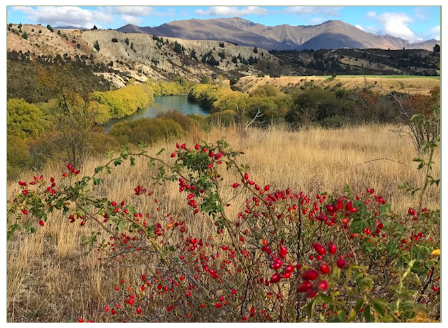Alison Carrington,
Graduate Practitioner, Paua Clinic
Embracing the changing seasons
Every season brings its own blessings, but for me, Autumn is my favourite time of the year. I was recently in Central Otago, enjoying the breath-taking beauty of the area, and the Autumn Festival of Color in Arrowtown. The trees have all turned on a showy, vibrant display of red, orange and yellow in a last-ditch effort to impress, before they start to conserve their energy and hunker down for the freezing winter ahead.
This is also the time of year for wild-harvesting Rose-Hips, whose thorny branches are hanging heavy with their bright red and orange fruit. I have always been intrigued by the vast numbers of rose bushes bushes that grow wild on every mountain and along every rivers’ edge in the Central Otago district. This species, Rosa rubiginosa is not native to New Zealand; legend has it that Chinese goldminers, as far back as the 1860’s, brought the roses to New Zealand in the knowledge that they would need a source of Vitamin C to help them survive the harsh Otago winters. The birds (and perhaps also the rabbits) have helped to disperse the Rose-Hip seeds around the entire province.
The health benefits of Rose-Hips is nothing new. During World War II, due to the lack of citrus fruit, the British Government encouraged people to plant Sweet Briar Roses for their Rose Hips. When I was a child, in the days when mums still preserved fruit and made jam, my parents used to bundle us into the car and head out into riverbanks and back-country land to pick wild blackberries and rose-hips. It was a lot of fun and quite the adventure. I never seemed to be able to find many to bring back, but my stained fingers and clothing may have told a different story! The knowledge and use of Rose Hips appears to be fading and their recipes forgotten, but this fruit is freely available and is a great way of enhancing our health as we head into winter. If you are lucky enough to be able to forage for this exceptional fruit you might enjoy these recipes; they are some my grandmothers would have used:
Rose Hip Syrup
- 500g rosehips
- 1.5L boiling water
- 500g sugar
- Chop up the rosehips or simply put them in the food processor until they’re chopped up into small pieces. Add them to 1L of boiling water in a pot on the stove. Bring to the boil.
- Turn off the heat, cover and leave to infuse for half an hour. Strain the hips through some muslin, a jelly bag or a clean tea towel and put the liquid to one side.
- Take the pulp and put it back in the pot with 500ml of boiling water. Bring to the boil, then turn off the heat and leave to infuse for a further 30 minutes.
- Strain and add the liquid to your first measure of infused liquid. Clean the pan, then put the liquid into it and simmer until the volume has reduced by half. Add the sugar and stir until dissolved, then bring to the boil and simmer at a rolling boil for 5 minutes.
- Bottle in sterilised glass bottles or jars and store in a cool place.
Rose-Hip Tea
(makes enough for 2 servings)
- 12-15 rose hip berries
- 2 ½ cups water
- Place washed Rose Hips into a small pot and cover with water. Bring the water to the boil and let boil for 3-5 minutes.
- Turn off the heat and use the back of a spoon to smash open the soft Rose Hips. Let them steep in the water for 20 minutes.
- Turn the heat back on to warm the tea. Pour through a coffee filter or muslin cloth into two cups. Enjoy!
Rose-Hips are best harvested after the first frost, about now. This tiny fruit is a powerhouse containing a rich source of Vitamins C, A, K and E, Vitamin B complex, also Zinc, Calcium, Iron, Sulphur Silicon Selenium, Manganese, Phosphorous, Potassium, and Magnesium. The antioxidant components include flavonoids, polyphenols, phytochemicals and carotenoids of the highest potency. Rose Hips are useful for treating conditions such urinary tract infections (much like cranberries in this way), colds, gastrointestinal disorders, diabetes, kidney disorders, and other infections. The seeds inside the Rose-Hip contain 77% fatty acids, which are high in linoleic (Omega-6) and linolenic acids (Omega-3). The essential fatty acids in the oil assist in cellular membrane and tissue regeneration, helping to reduce wrinkles and sun damage, soften stretch marks and scars, and helping with dermatitis, age spots, brittle nails, psoriasis, eczema, hyper-pigmentation and burns.
You can learn more about the amazing Rose-Hip in an article written by Medical Herbalist Sara Mertens for the NZAMH Avena magazine here:
http://nzamh.org.nz/wp-content/uploads/2016/09/WINTER-Avena-2016-WEBSITE.pdf
Nature has made sure we have what we need when we need it…we just need to know where to find it and how to use it!
References
Bone, K. (2003). A clinical guide to blending liquid herbs (1st ed.). St. Louis, Mo.: Churchill Livingstone.
Johnson, D. (2017). Foraging: Rose Hip Recipe for Tea – Eating Richly. Eating Richly. https://eatingrichly.com/foraging-rose-hip-recipe-for-tea/
Mertens, S. (2017) (1st ed.). Christchurch, New Zealand: NZAMH. http://nzamh.org.nz/wp-content/uploads/2016/09/WINTER-Avena-2016-WEBSITE.pdf
Nissen, W. (2014). Retro Recipe: Rosehip Syrup. Now To Love. http://www.nowtolove.co.nz/lifestyle/homes/retro-recipe-rosehip-syrup-19752
Schwager, J., Richard, N., Schoop, R., & Wolfram, S. (2014). A Novel Rose Hip Preparation with Enhanced Anti-Inflammatory and Chondroprotective Effects. hindawi.com.
What You Need to Know About Rosehip Seed Oil. (2017). Sustain, Create and Flow. http://www.sustaincreateandflow.com/what-you-need-to-know-about-rosehip-seed-oil/






